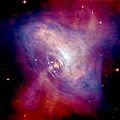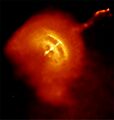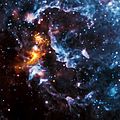Pulsar facts for kids
Pulsars are special neutron stars that spin very fast. They send out huge beams of electromagnetic radiation, which is a type of energy like light or radio waves. Neutron stars are super dense, meaning they pack a lot of stuff into a tiny space. They spin very regularly, like a perfect clock.
This fast, steady spin makes them send out pulses of energy at very precise times. These pulses can be as quick as milliseconds or as slow as a few seconds. We can only see a pulsar's pulse if its beam points towards Earth. Think of it like a lighthouse: you only see its light when the beam sweeps past you.
The pulses we see match the star's turns. This spinning creates the "lighthouse effect," where the energy is only visible for short moments. Scientists are still learning exactly how pulsars create and send out their energy.
Contents
Discovering Pulsars
The first pulsar was found in 1967 by Jocelyn Bell Burnell and Antony Hewish. They were researchers at the University of Cambridge. They noticed a strange signal that pulsed every 1.33 seconds, always coming from the same spot in the sky. This signal followed sidereal time, which means it was linked to the stars, not to Earth's rotation.
At first, they weren't sure what caused these regular changes in the signal's strength. They named these objects "pulsars," which is short for "pulsating stars." The first pulsar, now called CP 1919, sent out radio waves. Since then, scientists have found pulsars that also send out X-rays and gamma rays.
Nobel Prizes for Pulsar Discoveries
In 1974, Antony Hewish won the Nobel Prize in Physics. This caused some discussion because Jocelyn Bell Burnell, who made the first discovery as his student, did not share the prize. However, Bell herself has said she supports the Nobel committee's decision.
Later, in 1974, Joseph Hooton Taylor Jr. and Russell Hulse made another big discovery. They found the first pulsar that was part of a binary system. This means it orbited another neutron star. Their orbit was very fast, taking only eight hours.
Einstein's theory of general relativity predicted that such a system should give off strong gravitational radiation. This radiation would cause the stars' orbit to slowly shrink as they lost energy. Observations of this pulsar soon proved Einstein's prediction right. This was the first real evidence that gravitational waves exist. Taylor and Hulse won the Nobel Prize in Physics in 1993 for this important discovery.
Different Kinds of Pulsars
Astronomers have found three main types of pulsars:
- Rotation-powered pulsars: These pulsars get their energy from slowing down their spin. As the neutron star turns slower, it releases energy as radiation.
- Accretion-powered pulsars: Most of these are X-ray pulsars. They get their energy when matter from another star falls onto them. This falling matter creates X-rays that we can detect.
- Magnetars: These pulsars have incredibly strong magnetic fields. The radiation they send out comes from the energy lost by these powerful magnetic fields.
Even though all three are neutron stars, they act differently and are powered in different ways. However, they can sometimes change from one type to another. For example, some X-ray pulsars might be old rotation-powered pulsars. They "turn on" again when a nearby star expands and sends matter falling onto them. This process can even make them spin faster and become a rotation-powered millisecond pulsar again.
How Pulsars Are Used
Super Precise Clocks
Some millisecond pulsars are even more precise than an atomic clock. This amazing stability means they can be used to keep very accurate time. Scientists can use them to create "pulsar clocks" or to help measure time for space missions.
Sometimes, pulsars show tiny, random changes in their pulse timing. This is called "timing noise." Scientists are still studying why this happens.
Other Important Uses
Studying pulsars has led to many important discoveries in physics and astronomy.
- One major use was proving the existence of gravitational radiation. This was a key prediction from Einstein's theory of general relativity.
- Pulsars also helped scientists find the first proof of exoplanets, which are planets orbiting stars outside our solar system.
- In the 1980s, astronomers used pulsar signals to measure how the North American and European continents are slowly moving apart. This movement is strong evidence for plate tectonics, the theory that Earth's outer layer is made of large, moving plates.
Images for kids
-
Composite image of the Crab Nebula. It shows energy from the nebula, caused by magnetic fields and particles from the central pulsar.
-
Illustration of the "lighthouse" effect produced by a pulsar.
-
Chart on which Jocelyn Bell first recognised evidence of a pulsar.
See also
 In Spanish: Púlsar para niños
In Spanish: Púlsar para niños









